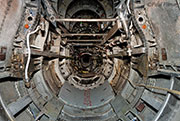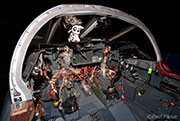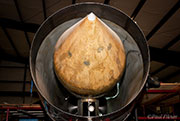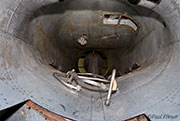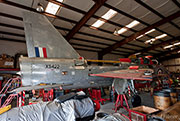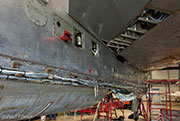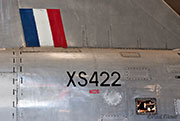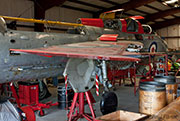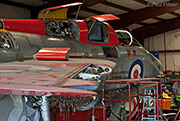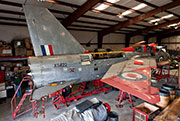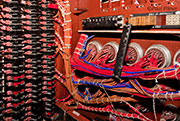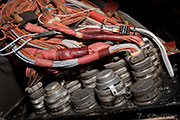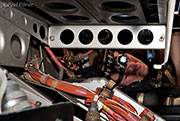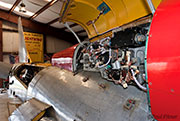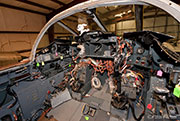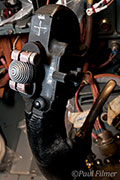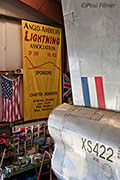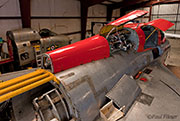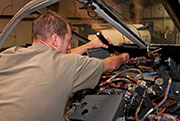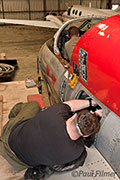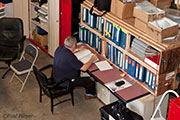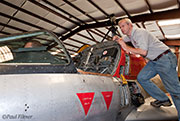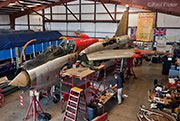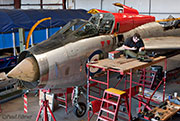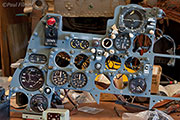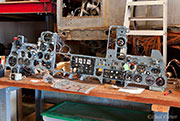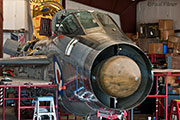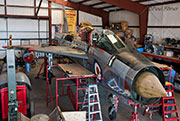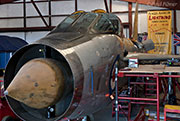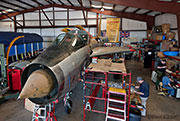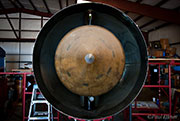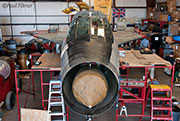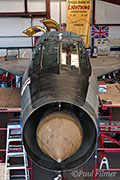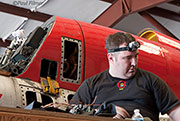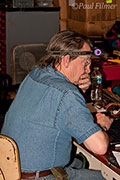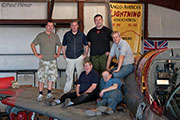With Thunder City in South Africa now closed for business after recent tragic events, one might think that the chances of seeing an English Electric Lighting in the air are again a thing of the past. There is a loyal band of volunteers who fly to Mississippi periodically whose goal is to prove this wrong. I visit the Anglo American Lightning Organisation (AALO) to catch-up on the progress made to date.
The Lightning T.5 in question is XS422 and was first flown on 24th March 1965 after being built at Salmesbury in Lancashire. She served with 226 OCU at Coltishall, 29 and 56 Squadrons at Wattisham before joining the Empire Test Pilots School (ETPS) at Boscombe Down from 1983 until August 1987 when she was withdrawn from service.
Along with another 21 aircraft, mostly ex-Saudi Air Force airframes that had been recovered back to Warton for a resale project by BAe that never matured, XS422 was broken apart and stored in three containers and sold to millionaire Wensley Haydon-Baillie. They were stored in Derbyshire for about eight years before Wensley's financial situation took a turn for the worse and the liquidators moved in. The containers were moved to Southampton and acquired by scrap merchant Marine Salvage who made it known that the aircraft were for sale to any interested parties.
Phil Wallis, AALO chief engineer, takes up the story. "In 1997 I received a phone call from Andrew Brodie asking if I could check out the 22 Lightnings that were stored in containers to find a suitable aircraft for restoration to flight. XS422 was selected as the prime aircraft along with a Saudi Air Force T.55 ZF595 (ex 55-714) as a spares aircraft. XS422 was picked because of its condition. Someone had got a cloth just before storage and had wiped a can of Waxol over the side of the fuselage which had helped to preserve the body of the aircraft from corrosion."
Andrew Brodie conceived the AALO in 1999 and the aircraft were shipped to Stennis Airport in Mississippi the same year. The Civil Aviation Authority (CAA) in the UK was well known by that time for its views regarding the civillian operation of the type in the UK - they wouldn't allow it - so the only option left was for them to be shipped out of the country. Stennis Airport was picked because a good friend of Andrew's, Jon Roth, a restorer of Stearmans, was based there and he was also persuaded to come onboard. The airport is out of the way and only a few miles from the Gulf of Mexico so it was the perfect location to operate such a noisy aircraft it. The single runway is a massive 8,497 feet long (2,590 metres) and is located close to the John C. Stennis Space Center and serves as a backup landing airport for the Space Shuttle.
The next task facing the team would be to put the aircraft back together. Phil continues: "In the years of storage the container roofs had rotted away leaving the aircraft exposed to water damage, and XS422 had water dripping onto the canopy, where it ran forward and dripped down between the canopy and windscreen, leaving a couple of inches of water laying inside the cockpit. All the flying controls and switches were seized and anything that was ferrous was corroded, so the only option would be to strip the cockpit down to nothing and build it from the floor up.
"The original plan was to graft the Saudi cockpit on to the good fuselage, as this was in much better condition. The cockpits were swapped but when the undercarriage was dropped it was found that the main casting that connects it to the fuselage was corroded. No one had ever replaced a pintal before so the original cockpit was put back on with the knowledge that it would need to be completely rebuilt. 3000 man hours have been spent on the cockpit to date but the end is nearly in sight to finish that off."
Phil's background is impressive. He had 31 years service in the RAF and retired three years ago. 12 of those years were working with the Lightning in most capacities including performing major servicing, right through to operating in the first-line environment with the squadrons. When the Lightning finished RAF service in 1988 he moved on to Tornadoes.
Other Lightning projects that Phil has been involved with include the build of XR770 - which is now on display at RAF Waddington - the Lightning Preservation Group's pair at Bruntingthorpe, and he was also the chief engineer on the one-off flight of XR724 from RAF Shawbury to RAF Binbrook in 1990. He is currently Deputy Chief Engineer with 32(TR) Squadron at RAF Northolt as a civilian contractor.
The pool of volunteers travel to the USA, on average, twice a year and are typically on-site for up to a month to work on the project in their own free time, and, as you can imagine, this makes the logistics of restoration both time consuming and complicated. The main focus for the group on this particular trip was electrical, including the final fitting of the main instrument panel.
The current state of play is that the hydraulic and fuel systems are finished, with both the mechanical and electrical jobs around 85% complete. If a sponsor was found now it could be taxying in a very short space of time. Phil estimates that XS422 could be flying with as little as £200,000-£300,000. When you compare this to the Vulcan this is very small change indeed. In fact the Vulcan and Lightning are very like-for-like task-wise, with the Vulcan simply being larger as the airframes are from the same era. In fact the Lightning has a major advantage as it has a finite life with no overhaul "gotchas", and this particular airframe could easily fly for 20 years with a good spares cache.
The aircraft is being maintained to RAF standards and a great deal of research and work was carried out in the '70s with the known fire integrity issues of the airframe, so the team is confident that an attention to detail will see them through. The restoration started with a "Check 4" service, which was the most in-depth service the RAF documented for the Lightning. It involves the inspection of every single component on the aircraft and was considered to be essential because of the way the aircraft had been stored for so long.
The man tasked with looking after the engines and documenting the spares is Geoff Commins who also has a rich Lightning background. Geoff was an RAF Halton apprentice who passed out in 1963 and went straight to 56 Squadron on Lightnings as a propulsion systems engineer. He also served on Lightnings with 111 Squadron and, after being de-mobbed, did three tours in Saudi Arabia working on its aircraft, plus a stint with BAC with their Lightnings and single Jaguar (E-02).
Outside of the government contracts Geoff worked with a number of private Lightning projects starting in 1987 with the Arnold Glass collection of six Lightnings at Cranfield, where the intention had been to fly them as civilian aircraft but this project was thwarted by the CAA and all the aircraft were sold on.
He later worked on Barry Pover's Lightning T.5 XS451 at Plymouth for future flight which of course also stalled in the UK as above. Geoff also helped to disassemble T.5 XS452 at Cranfield for its journey to South Africa, and after this flew down to Cape Town on numerous occasions to lend a hand with the Lightnings at Thunder City. He also worked with Phil Wallis on the Binbrook move in 1990. Geoff became one of the AALO volunteers around 2000 and continues to be a very hands-on member of the team as well as bringing his vast experience and knowledge to the project in an advisory role.
AALO has four ex-Saudi engines in their inventory with one clocked at 160 hours and the rest being zero timed, and with a 400 hour life that's a nice stock. 70% of the spares cache is structural and contains many components that probably will never need replacing. The things in short supply are parts like hydraulic valves, electrical components; basically anything that moves and can break.
Another of the main players in this project is Rod Barker who heads up the avionics and electronics part of the build. Originally a third-line maintenance radio technician with the RAF, he also went on to work for BAC in Saudi Arabia with the Lightnings and ended up working in the Met Office as a radio technician and instrument physicist. Rod worked with T.5 XS458 at Cranfield in 1999 and currently also assists with the ex-Saudi F.53 53-671 at the Gatwick Aviation Museum at Charlwood in Surrey. This aircraft in many ways serves as a test-bed for the XS422 project and also keeps him "Lightning current".
One of the biggest headaches with the electrical side was when the airframe was cut for storage. Obviously the wires needed to be snipped, but many were never labeled, so it was a huge undertaking to identify and reconnect the wires correctly. They didn't come across many defects in the initial wire-up but the re-heat section gave them headaches as many of the connections were cross-wired which took one complete trip to the USA to fix.
The DC wiring is complete to all basic systems and the rest of the electrics are expected to be completed by the end of the next trip. All the testing for the actuators and black boxes that interpret the electronic signals are tested in the UK either by Rod or another expert in the field, and will be brought to base when needed. All of the original wiring was in excellent condition so hardly any actually needed to be replaced. This is because very heavy duty wiring was incorporated into these machines; called tersil, it is made of a heavily nickel plated, hard-drawn copper, with a silicone sheet over the top and a woven double-layer fibreglass sheet on top of that. It can literally last forever and withstand enormous temperatures.
Apart from Nic Holman who is the Supporters' Club president, the media coordinator and film documenter for the project, there were a further two electricians both currently serving with the RAF present on this trip.
Gary Hurst started out on VC-10s with 101 Squadron and now works at RAF Coningsby on the Typhoon in the electronic support software side. He got involved with AALO in 2006 and found that many of the relays fitted to the VC10 were common to the Lightning, so suddenly things looked a little familiar. He got involved via Max Waldren and Phil Wallis as all three work at RIAT every year and after a quiet word the seeds were sown.
Derek "Bo" Brocklesby works as an electrician and has worked mostly with Tornadoes, including in Germany and Italy - during the Yugoslavia crisis - and also The Falklands Campaign, plus a year long secondment to Saudi Arabia, again on Tornadoes. He met Phil when they were both instructors at the Tornado Maintenance School and came out to Mississippi for the first time nine years ago.
Phil sums up the project as being, "Like trying to restore an old car with one hand tied behind your back. The hand that is tied is the financial one and we are limited by the amount of money that is available. The whole process is basically governed by money."
I only met a small section of the many volunteers who are involved in this ambitious and complicated project, but they are all highly skilled and very motivated, but of course there are still many obstacles holding it back which have been touched on above. If the funds keep rolling in at their current rate, it's possible that XS422 could be ground running in 18 months.
I certainly hope that the end result is achieved and would like to thank Nic Holman and all the volunteers for their warm welcome and hospitality. For further information and details on becoming a sponsor, donor or volunteer visit the AALO website
Subscribe to receive updates via: e-mail list | Facebook | Instragram | Twitter
[photo/serial list]
